☆ PuniPuni Youtube ☆
Japanese Grammar – Plain Past Form of Verbs – Review Notes
As we learned in our last Japanese grammar lesson, there are 3 types of Japanese verbs.
In today’s grammar lesson, we learned how to change verbs in each of the 3 verb classes from Plain Present to Plain Past, also known as the ta-form.
In these video review notes we will go over today’s Japanese grammar in greater detail and see a list of verbs!
………………………………………………………………………………..
Today’s Grammar Lesson:
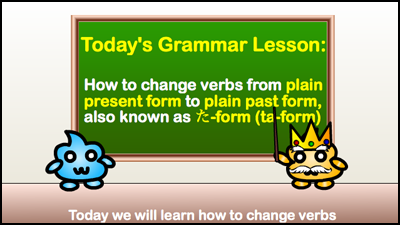
★ Today we will learn how to change verbs from plain present form to plain past form, also known as た-form (ta-form).
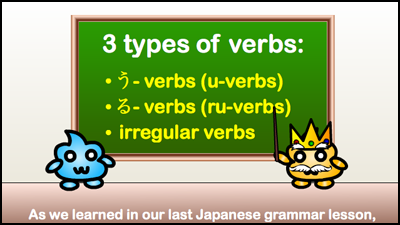
★ We learned last time that there are 3 classes of Japanese verbs:
★ う-verbs (u-verbs)
★ る-verbs (ru-verbs)
★ irregular verbs
………………………………………………………………………………..
Changing う-verbs (u-verbs) to た-form
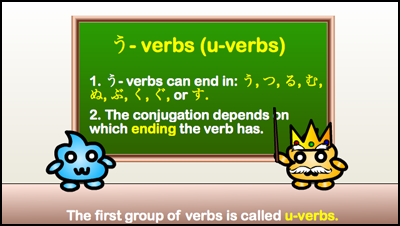
★ The first type of Japanese verbs is called う-verbs (u-verbs).
★ う-verbs (u-verbs) can end in う (u), つ (tsu), る (ru), む (mu), ぬ (nu), ぶ (bu), く (ku), ぐ (gu), or す (su)
★ Depending on which ending the う-verb (u-verb) has, there are different ways to conjugate it.
………………………………………………………………………………..
う-verbs that end in う (u), つ (tsu) or る (ru)
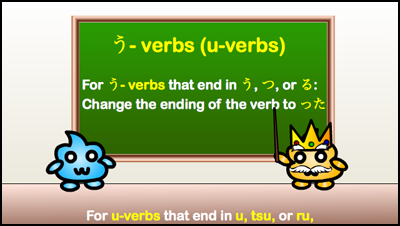
★ For u-verbs that end in う (u), つ (tsu), or る (ru), you should change the ending to った (tta)
………………………………………………………………………………..
Example 1: Verb ending in う (u)
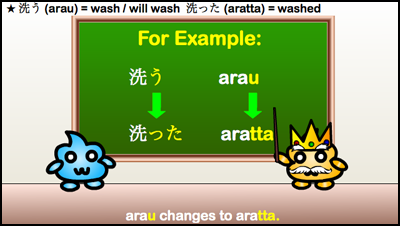
★ 洗う (あらう – arau) – wash/will wash – changes to 洗った (あらった – aratta) – washed.
………………………………………………………………………………..
Example Sentence Plain Present:
後でお皿を洗うつもりです。
Ato de osara o arau tsumori desu.
I intend to wash the dishes later.
………………………………………………………………………………..
Example Sentence Plain Past:
彼はもう洗ったと思います。
Kare wa mou aratta to omoimasu.
I think he already washed (them).
………………………………………………………………………………..
Example 2: Verb ending in つ (tsu)
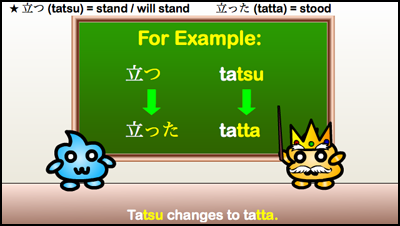
★ 立つ (たつ – tatsu) – stand / stand up – changes to 立った (たった – tatta) – stood / stood up
………………………………………………………………………………..
Example Sentence Plain Present:
立つな!
Tatsu na!
Don’t stand up!
………………………………………………………………………………..
Example Sentence Plain Past:
赤ちゃんが立った。
Akachan ga tatta.
The baby stood up.
………………………………………………………………………………..
Example 3: Verb ending in る (ru)
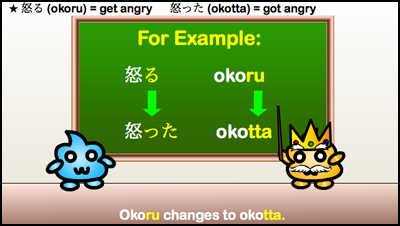
★ 怒る (おこる – okoru) – to get angry – changes to 怒った (おこった – okotta) – got angry.
………………………………………………………………………………..
Example Sentence Plain Present:
お母さんはすぐ怒る。
Okaasan wa sugu okoru.
My mom is quick to get angry.
………………………………………………………………………………..
Example Sentence Plain Past:
お父さんが怒った。
Otousan ga okotta.
My dad got angry.
………………………………………………………………………………..
う-verbs that end in む (mu), ぬ (nu), ぶ (bu)
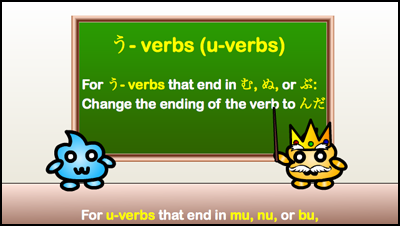
★ For u-verbs that end in む (mu), ぬ (nu), or ぶ (bu), you should change the ending to んだ (nda)
………………………………………………………………………………..
Example 1: Verb ending in む (mu)
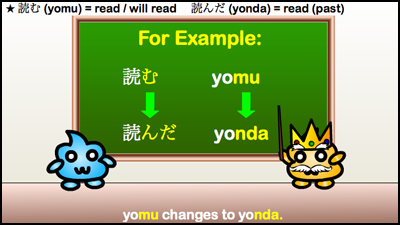
★ 読む (よむ – yomu) – read/will read – changes to 読んだ (よんだ – yonda) – read (past).
………………………………………………………………………………..
Example Sentence Plain Present:
私は毎日新聞を読む。
Watashi wa mainichi shinbun o yomu.
I read the newspaper every day.
………………………………………………………………………………..
Example Sentence Plain Past:
今週本を3冊読んだ。
Konshuu hon o sansatsu yonda.
I read 3 books this week.
………………………………………………………………………………..
Example 2: Verb ending in ぬ (nu)
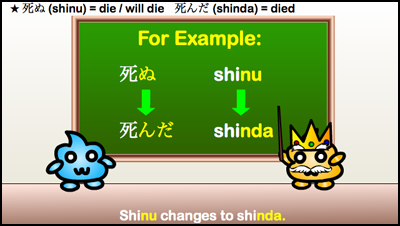
★ 死ぬ (しぬ – shinu) – to die/will die – changes to 死んだ (しんだ – shinda) – died.
★ It is best to avoid using these words as much as possible. It is better to use the words 亡くなる (なくなる – nakunaru) – pass away – or 亡くなった (なくなった – nakunatta) – passed away.
………………………………………………………………………………..
Example 3: Verb ending in ぶ (bu)
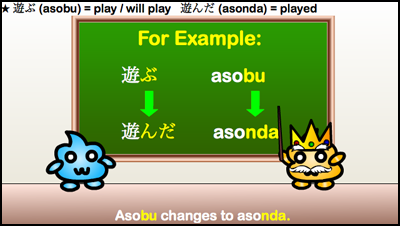
★ 遊ぶ (あそぶ – asobu) – play/will play – changes to 遊んだ (あそんだ – asonda) – played.
………………………………………………………………………………..
Example Sentence Plain Present:
友達と遊ぶ。
Tomodachi to asobu.
I will play with my friend.
………………………………………………………………………………..
Example Sentence Plain Past:
一人で遊んだ。
Hitori de asonda.
I played by myself.
………………………………………………………………………………..
う-verbs that end in く (ku)
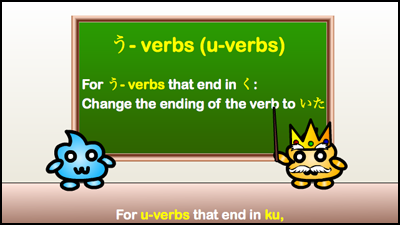
★ For u-verbs that end in く (ku) you should change the ending to いた (ita)
………………………………………………………………………………..
Example: Verb ending in く (ku)
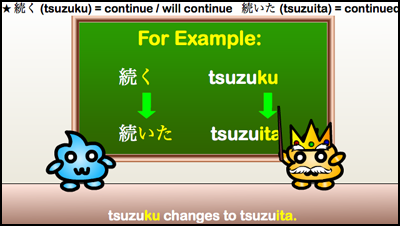
★ 続く (つづく – tsuzuku) – continue/will continue – changes to 続いた (つづいた – tsuzuita) – continued
………………………………………………………………………………..
Example Sentence Plain Present:
次のページへ続く。
Tsugi no pēji e tsuzuku.
I will continue to the next page.
………………………………………………………………………………..
Example Sentence Plain Past:
雨が降り続いた。
Ame ga furi tsuzuita.
Rain continued to fall.
………………………………………………………………………………..
う-verbs that end in ぐ (gu)
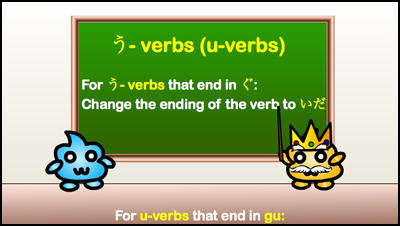
★ For u-verbs that end in ぐ (gu) you should change the ending to いだ (ida)
………………………………………………………………………………..
Example: Verb ending in ぐ (gu)
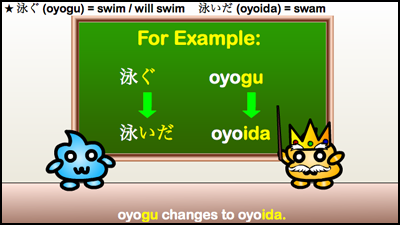
★ 泳ぐ (およぐ – oyogu) – swim/will swim – changes to 泳いだ (およいだ – oyoida) – swam.
………………………………………………………………………………..
Example Sentence Plain Present:
私は毎日3キロを泳ぐ。
Watashi wa mainichi sankiro o oyogu.
I swim 3 kilometers every day.
………………………………………………………………………………..
Example Sentence Plain Past:
昨日海で泳いだ。
Kinou umi de oyoida.
Yesterday I swam in the ocean.
………………………………………………………………………………..
う-verbs that end in す (su)
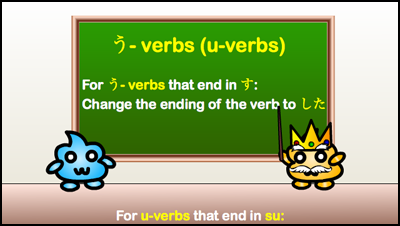
★ For u-verbs that end in す (su) you should change the ending to した (shita)
………………………………………………………………………………..
Example: Verb ending in す (su)
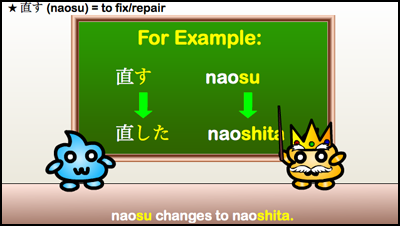
★ 直す (なおす – naosu) – to fix/repair – changes to 直した (なおした – naoshita) – fixed/repaired.
………………………………………………………………………………..
Example Sentence Plain Present:
壊れたテレビを直す。
kowareta terebi o naosu.
I will fix the broken TV.
………………………………………………………………………………..
Example Sentence Plain Past:
彼は私のコンピュータを直した人です。
Kare wa watashi no konpyūta o naoshita hito desu.
He is the person who fixed my computer.
………………………………………………………………………………..
An Exception to U-verb Rules:
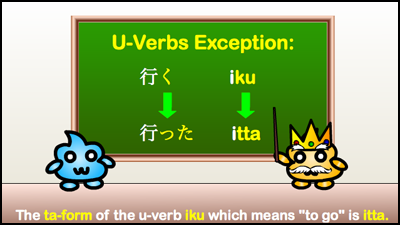
★ An exception to the rules is the verb 行く (いく – iku) – to go.
★ It ends in く (ku) so if you follow the normal rules it would change to 行いた (iita), but this is not correct. The past tense of 行く (いく – iku) is 行った (いった – itta).
………………………………………………………………………………..
Changing る-verbs (ru-verbs) to た-form
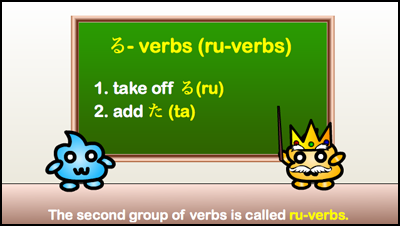
★ The second group of Japanese verbs are called る-verbs (ru-verbs).
★ る-verbs (ru-verbs) are always simple.
★ To change a る-verb (ru-verb) to Plain Past form, just take off る (ru) and add た (ta)
………………………………………………………………………………..
Example 1: 見る (miru)

★ 見る(みる – miru) – to see/watch changes to 見た (みた – mita) – saw/watched
………………………………………………………………………………..
Example Sentence Plain Present:
私は毎日テレビを見る。
Watashi wa mainichi terebi o miru.
I watch TV everyday.
………………………………………………………………………………..
Example Sentence Plain Past:
その映画はもう見た。
Sono eiga wa mou mita.
I already saw that movie.
………………………………………………………………………………..
Example 2: 教える (oshieru)
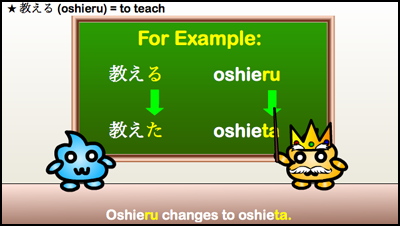
★ 教える(おしえる – oshieru) – teach/will teach changes to 教えた (おしえた – oshieta) – taught.
………………………………………………………………………………..
Example Sentence Plain Present:
私は子供に日本語を教えるつもりです。
Watashi wa kodomo ni nihongo o oshieru tsumori desu.
I intend to teach Japanese to my children.
………………………………………………………………………………..
Example Sentence Plain Past:
私は子供に日本語を教えた。
Watashi wa kodomo ni Nihongo o oshieta.
I taught Japanese to my children.
………………………………………………………………………………..
Example 3: 落ちる (ochiru)
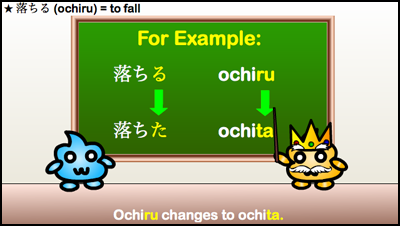
★ 落ちる(おちる – ochiru) – to fall – changes to 落ちた (おちた – ochita) – fell.
………………………………………………………………………………..
Example Sentence Plain Present:
落ちる!
Ochiru!!
I’ll fall!!
………………………………………………………………………………..
Example Sentence Plain Past:
石が落ちた。
Ishi ga ochita.
A rock fell.
………………………………………………………………………………..
Changing Irregular Verbs to Plain Past
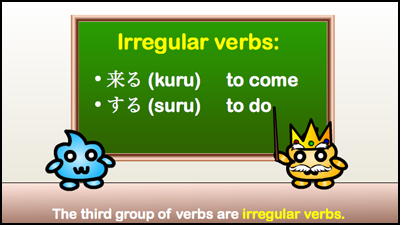
★ There are only 2 irregular verbs in Japanese:
★ 来る(くる – kuru) which means ‘to come’
★ する (suru) which means ‘to do’
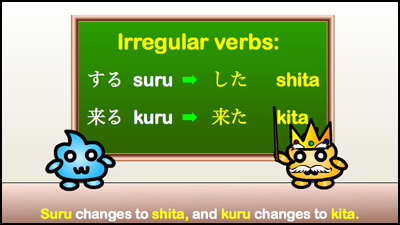
★ 来る (くる – kuru) changes to 来た(きた – kita) – came
★ する (suru) changes to した (shita) – did
………………………………………………………………………………..
List of Japanese Verbs in Plain Past Form:
………………………………………………………………………………..
List of some common う-verbs in た-form:
会った あった atta met
騙した だました damashita tricked
選んだ えらんだ eranda chose
太った ふとった futotta gained weight
頑張った がんばった ganbatta did (one’s) best
入った はいった haitta entered
話した はなした hanashita talked
払った はらった haratta payed
光った ひかった hikatta shined
買った かった katta bought
聞いた きいた kiita listened
守った まもった mamotta protected
待った まった matta waited
持った もった motta had
泣いた ないた naita cried
思った おもった omotta thought
使った つかった tsukatta used
動いた うごいた ugoita moved
歌った うたった utatta sung
……………………………………………………………………………….
List of some common る-verbs in た-form:
開けた あけた aketa opened
褒めた ほめた hometa praised
入れた いれた ireta put in
考えた かんがえた kangaeta thought
借りた かりた karita borrowed
片付けた かたづけた katazuketa tidied up
数えた かぞえた kazoeta counted
消えた きえた kieta disappeared
聞こえた きこえた kikoeta heard
答えた こたえた kotaeta answered
見せた みせた miseta showed
捨てた すてた suteta threw away
助けた たすけた tasuketa saved/helped
足りた たりた tarita was enough
疲れた つかれた tsukareta got tired
忘れた わすれた wasureta forgot
……………………………………………………………………………….
Next Grammar Lesson:
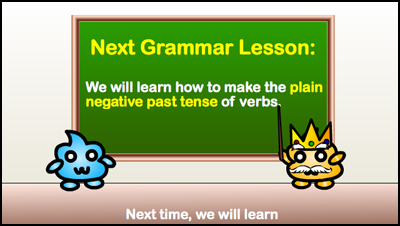
★ Next time we will learn how to make the Plain Negative Past Tense of verbs!
……………………………………………………………………………….
Do you want a Japanese tutor?
Take Japanese Skype Lessons with Professional Japanese Teachers on kakehashijapan.com!
………………………………………………………………………………..
………………………………………………………………………………..









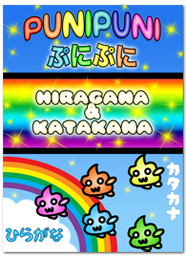
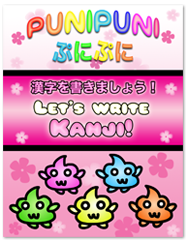


2 comments
I don’t know when to use this tense. I thought the past tense was formed with 「ました」and 「ませんでした」。I am kinda lost and don’t know when to use which. And uhe た~form has no negative form? can this form be used as a の~adjetive as : 開けたのとびら?Thanks, I appreciate what you do.
Comment by 花小 on 04/13/2014 at 4:20 amThere is a negative form of the plain past verbs: Instead of た (ta) you use なかった (nakatta). For example 食べた (tabeta – ate) changes to 食べなかった (tabenakatta – didn’t eat). There are many cases when you might use the plain form instead of the polite form (ました and ませんでした). But, if you are just starting out with Japanese grammar, it might be better to stick with the polite form until you are ready.
Basically, the plain form is used in casual situations and the polite form is used in formal situations. However, you can also make this negative plain form (なかった) into a polite form by adding です to the end. When you do this, it is the same as using ませんでした.
Check this lesson to learn more about the negative plain form of verbs: http://www.punipunijapan.com/japanese-verbs-plain-past-negative/
Comment by PuniPuni on 04/14/2014 at 5:26 am